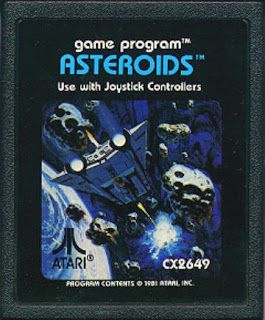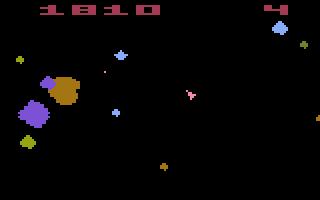
Atari Poop
Asteroids
The Atari 2600 port of the 1979 arcade classic Asteroids explonded onto the console in 1981 (coincidentally, the same year the greatest person to walk the Earth was born). Everyone loved playing as a small triangle that could shoot things, but Asteroids was so much more than just that.

Plot:
What most people don’t realise is that Asteroids, while superficially coming across as a shmup where a triang…I mean, spaceship must shoot down incoming asteroids and stuff, the game is really a deeply layered allegory on adolescence. It was a mature game if there ever was one and a strong case can be made arguing that this game is simply a work of art. Putting the player in the shoes of a nameless teenager forced to navigate the dangerous terrain that is a typical high school, it is one of the earliest examples of a sandbox game. It is also the inspiration for Rockstar’s Bully.
Sound:
The teenage years are a tumultuous time and Asteroids perfectly conveys this despite the limitations of the console. Right from the start, the music sets the tone: dark, ominous, threatening, and foreboding. It sounds a lot like some strange version of the main “shark” theme from Jaws, which just happens to be the perfect soundtrack to that bully walking down the hallway towards you, or you heading towards your crush to tell them how you feel.
The sound of your ship shooting, on the other hand, is a dinky, little, pathetic, and high pitched blip. The contrast between this sound and that of the music is stark and plays on the insecurities felt by teenagers.
Graphics:
Then we have the visuals: you are a pink triangle in a sea of black. What may look like what some people would label “shitty graphics” is actually 100% deliberate on the part of the game’s creators. Every colour, every shape, and every pixel has a purpose.
Pink here, the colour of the spaceship and therefore the teenaged protagonist, is meant to convey innocence, weakness, frailty, and naïveté. The black represents the world a typical adolescent finds themselves in: a school, and more specifically, a high school. It’s a dull, pointless, colourless environment that seems to have been conceived solely to inspire depression in its denizens… you know, just like your high school. When I started high school, we were greated on the first day by the older students with a single message: “Welcome to prison.” This game’s graphics welcome you with the same message.
Next, we have the asteroids themselves. They come in different colours, shapes, and sizes, yet they are not unique. They only come in a few colours, shapes, and sizes, while none of them appear to be similar to your colour, shape, or size. There is a reason for this. The asteroids represent the other students, students who all seem to be able to find people just like themselves to befriend. Regardless of how many asteroids there may be, mingling with each other, forming cliques, you are doomed to be forever alone.
Finally, we have the enemy ships. At this point, it should be obvious who these represent. The asteroids do not seem to notice you. If they bump into you, it is purely by mistake as they are not even aware of your existence. The ships, on the other hand, actively seek you out; they are the bullies and teachers, the ones who sole purpose is to destroy you or at least make your life as miserable as possible.
Gameplay:
This is where the game goes from great to masterpiece, where all of the previous elements combine to create one the most engrossing and complete video game experiences ever created.
As a teen, you yearn for friendship, love, and meaning in your life. As a result, you might try to approach a classmate and say “Hi” in an attempt to start a conversation. Often, you’ll be greeted with “Uhh, who are you?”, followed by the laughter of everyone around you. They are definitely not laughing with you. Now you feel like dying. In Asteroids, you might tentatively engage your thrusters and slowly approach an asteroid, or simply wait for an asteroid to eventually come to you, not knowing any better. “Uh, excuse me… BANG!”, you’re dead. Let’s try that again. “Hi, my name…” “BANG!” Dead again.
“Well fuck this and fuck them!! All of them!! I don’t need them! I’ll by fine just by myself,” you might have thought to your teenaged self. So when an asteroid/potential friend approaches you, you start shooting at them before they get too close: “BANG! They’re dead!”, thus perpetuating the problem in a never-ending vicious circle of pain and regret.
To escape all of this, you might try to fly yourself away from all the asteroids. As you slowly edge yourself closer to the edge of the screen, you will soon discover, to your horror, that if you manage to reach one edge, you simply reappear on the opposite side. Remember when I compared it to a prison?
But the game doesn’t just stop there. One final touch the developers added was “Hyperspace,” the ability to momentarily disappear and then reappear elsewhere. This is similar to hiding from the bullies by getting into your locker…or committing suicide. That’s right, hyperspace may get you to safety, but it may also make you appear right next to or even on an asteroid, killing you instantly. It’s a calculated risk, one most teenagers have contemplated at one time or another. It reminds me of a line in the song “A Single Second” by A.F.I.: “I never wanted to cease to exist, just disappear.”
Only once we are older do we see in horror the brutal truth; that in the end, we were are all little pink triangles in oceans of black, trying to stay out of each other’s and avoid getting hurt. And there you have it: Asteroids for the Atari 2600, a.k.a. the world’s most advanced teenage simulator.
